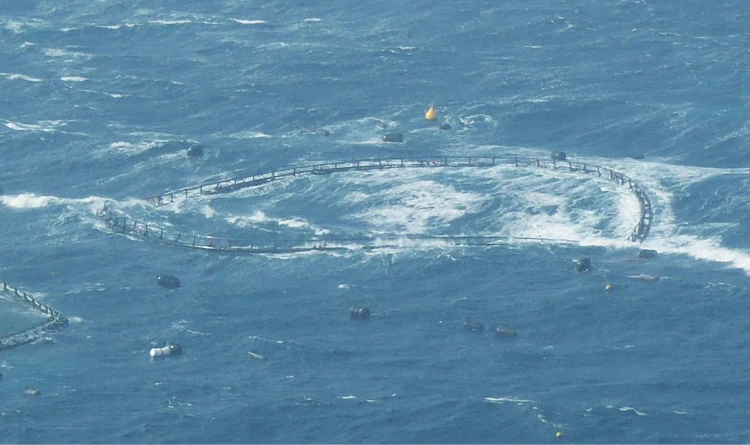Disaster Countermeasures

Preparation for unpredictable natural disasters
Nature never behaves as we want it to, and commercial fishing has developed through the accumulation of knowhow and techniques to avoid the threats it poses. Nitto Seimo has developed new technologies to help further prevent misfortune in the modern age. The aquaculture industry is particularly exposed to the dangers of the natural world, and we are changing it for the better.
Challenges in Aquaculture
Climate change is
resulting
in a greater frequency
of natural disasters

As global warming causes more frequent and severe typhoons and other natural disasters, the aquaculture industry and its coastal fish cages are at particularly high risk of experiencing severe damage. In 2013, for example, the Philippines was hit by a super typhoon said to be a once-in-a-century event, devastating the major local industries of fishing and aquaculture. Aquaculture farms with numerous fish cages were washed away along with the fish they were cultivating, leaving nothing behind.
Increasing facility
robustness comes
with the challenge
of increased cost

When typhoons hit, aquaculture farms suffer damage in terms of both fish cages and cultivated fish. It’s best to set up fish cages in calm waters that are less susceptible to being affected by waves. Unfortunately, however, the best areas are often already in use, and if you want to start a new business, you are forced to choose a higher-risk location with more severe sea conditions. And increasing facility robustness involves considerable costs and could make a venture unprofitable.
Our Idea
Can we reduce
the impact of
typhoons by sinking
fish cages at will?
Nitto Seimo sought to find a method that enables aquaculture to be carried out even in seas with more severe conditions while keeping costs down. Our aim was to create a way of sinking fish cages during typhoons and other stormy weather. The force of waves is stronger near the sea surface and weaker underwater. We thought that if customers could submerge their fish cages underwater at will, it would reduce the impact of typhoons not only on the facilities but also on the valuable fish being cultivated inside.
Solution
Submersible fish cages
that can avoid the effects
of stormy seas

Our submersible aquaculture technology makes use of high-density polyethylene (HDPE) pipes whose buoyancy can be controlled by filling the pipes with either water or air as needed. By releasing a valve, water floods into the pipes, causing the cage to submerge. Air can then be pumped back in by a compressor, expelling the water and bringing the cage back to the surface. This system makes it possible to avoid the impact of rough seas during inclement weather. This, in turn, enables the cultivation of fish in areas with more severe sea conditions that were previously largely unutilized.

Nitto Seimo has provided this submersible aquaculture technology to the Philippines to support reconstruction efforts in areas affected by the super typhoon discussed above. Devising a way to use locally-available materials and local labor to create submersible fish cages, Nitto Seimo has supported local residents in achieving reconstruction with their own hands.

Our submersible aquaculture technology can also be used for more than dealing with natural disasters. Examples of the potential uses of this technology include keeping fish in optimum water temperature ranges by submerging fish cages at depths where the water temperature is lower than that of the sea surface, avoiding damage caused by red tides, and preventing sunburns to cultivated fish caused by ultraviolet rays.
